
A derecho is a widespread, long-lived, straight-line wind storm that is associated with a fast-moving group of severe thunderstorms known as a mesoscale convective system.
The heat wave of 1995 derecho series are a series of derechos that occurred from July 11 through July 15, 1995, primarily impacting areas from Montana to the US Midwest, and the Great Lakes Region.

The Independence Day Derecho of 1977 was a derecho, or long-lived windstorm associated with a fast-moving band of thunderstorms, that swept across the Great Lakes region of the U.S. on July 4, 1977. It lasted around 15½ hours. The derecho formed in Minnesota around 10 a.m. CDT on July 4 and became more intense around noon in the central part of the state. The derecho produced winds of 80–100 mph (130–160 km/h) in northern Wisconsin, felling thousands of trees.
The Boundary Waters–Canadian Derecho was an international derecho that occurred during the afternoon and evening hours of July 4 and the early morning hours of July 5, 1999. It traveled 1,300 miles (2,092 km) and lasted 22 hours.
The Southern Great Lakes Derecho of 1991 is the derecho event that occurred on July 7 and 8, 1991. It lasted 17 hours and raced from South Dakota through southern Michigan before dying out over Western Pennsylvania.
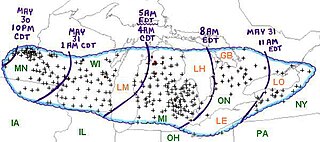
The Late-May 1998 tornado outbreak and derecho was a historic tornado outbreak and derecho that began on the afternoon of May 30 and extended throughout May 31, 1998, across a large portion of the northern half of the United States and southern Ontario from southeastern Montana east and southeastward to the Atlantic Ocean. The initial tornado outbreak, including the devastating Spencer tornado, hit southeast South Dakota on the evening of May 30. The Spencer tornado was the most destructive and the second-deadliest tornado in South Dakota history. A total of 13 people were killed; 7 by tornadoes and 6 by the derecho. Over two million people lost electrical power, some for up to 10 days.

This page documents notable tornadoes and tornado outbreaks worldwide in 2006. Strong and destructive tornadoes form most frequently in the United States, Bangladesh, and Eastern India, but they can occur almost anywhere under the right conditions. Tornadoes also develop occasionally in southern Canada during the Northern Hemisphere's summer and somewhat regularly at other times of the year across Europe, Asia, Argentina, Brazil and Australia. Tornadic events are often accompanied with other forms of severe weather, including strong thunderstorms, strong winds, and hail.
The heat wave of 2006 derecho series were a set of derechos — severe winds with powerful thunderstorms — that occurred on July 17–21, 2006. The first storms hit a wide swath of north-central and northeastern North America that stretched from the Upper Midwest through much of Ontario and into the northeastern United States. Another round struck the middle Mississippi River Valley, including two derechos that hit St. Louis, Missouri. The storms left more than three million people without power, some more than once and some for weeks.
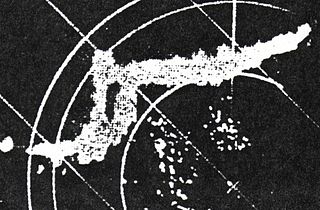
The Ohio Fireworks Derecho, was a severe wind event that took place during the evening hours of July 4 1969. It affected the northern half of the state of Ohio as well as portions of Pennsylvania, southern Michigan, northern West Virginia and extreme southwestern New York. It was one of the numerous events of that type that hit a region in the United States during its national holiday, the others being in 1977, 1980, and 1999.

This page documents the tornadoes and tornado outbreaks that occurred in 2007, primarily in the United States. Most tornadoes form in the U.S., although some events may take place internationally, particularly in parts of neighboring southern Canada during the summer season. Some tornadoes also take place in Europe, e. g. in the United Kingdom or in Germany.

Severe weather is any dangerous meteorological phenomenon with the potential to cause damage, serious social disruption, or loss of human life. Types of severe weather phenomena vary, depending on the latitude, altitude, topography, and atmospheric conditions. High winds, hail, excessive precipitation, and wildfires are forms and effects of severe weather, as are thunderstorms, downbursts, tornadoes, waterspouts, tropical cyclones, and extratropical cyclones. Regional and seasonal severe weather phenomena include blizzards (snowstorms), ice storms, and duststorms.
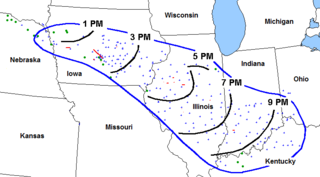
The Corn Belt derecho was a progressive derecho which affected a large area of the central United States on June 29, 1998. In the morning, thunderstorms, including a supercell, developed over South Dakota and tracked into central Iowa. As the thunderstorms reached central Iowa, a strong rear-inflow jet developed which caused the thunderstorm to take on a different characteristic, becoming a derecho. It traveled more than 600 miles in about ten hours, causing more than $125 million worth of widespread damage destruction, especially to crops, and was responsible for power outages to nearly a half a million people.
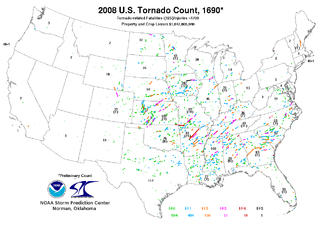
This page documents notable tornadoes and tornado outbreaks worldwide in 2008. Strong and destructive tornadoes form most frequently in the United States, Bangladesh, and Eastern India, but they can occur almost anywhere under the right conditions. Tornadoes also develop occasionally in southern Canada during the Northern Hemisphere's summer and somewhat regularly at other times of the year across Europe, Asia, and Australia. Tornadic events are often accompanied with other forms of severe weather, including strong thunderstorms, strong winds, and hail.

The June 2010 Northern Plains tornado outbreak was one of the most prolific summer tornado outbreaks in the Northern Great Plains of the United States on record. The outbreak began on June 16, with several tornadoes in South Dakota and Montana. The most intense storms took place the following day across much of eastern North Dakota and much of Minnesota. The system produced 93 tornadoes reported across four states while killing three people in Minnesota. Four of the tornadoes were rated as EF4 on the Enhanced Fujita scale, the most violent tornadoes in a 24-hour period since there were five within 15 hours in the 2008 Super Tuesday tornado outbreak. This was the region's first major tornado outbreak of the year and one of the largest on record in the region, comparable to a similar outbreak in June 1992. The 48 tornadoes that touched down in Minnesota on June 17 marked the most active single day in the state's history. June 17 was the second largest tornado day on record in the meteorological summer, behind the most prolific day of the 2003 South Dakota tornado outbreak on June 24, 2003.

This page documents the tornadoes and tornado outbreaks of 2011. Extremely destructive tornadoes form most frequently in the United States, Bangladesh, Brazil and Eastern India, but they can occur almost anywhere under the right conditions. Tornadoes also appear regularly in neighboring southern Canada during the Northern Hemisphere's summer season, and somewhat regularly in Europe, Asia, and Australia.

From June 12 to June 13, 2013, two derechos occurred across different areas of the Eastern United States. The initial derecho formed on the afternoon of June 12 and tracked across a large section of the Midwestern United States, the central Appalachians, and the Mid-Atlantic states before moving into the Atlantic Ocean during the morning of June 13. A second, more widespread and intense derecho occurred on June 13 across the Southeastern United States, resulting in major wind damage across North Carolina, Virginia, and Maryland, among other states. These storms caused at least three deaths and extensive damage property damage – resulting from both tornadoes and straight-line winds – from Iowa to South Carolina. 28 tornadoes touched down in Iowa, Illinois, Ohio, Georgia, North Carolina, Maryland, Virginia, and Tennessee. One of the tornadoes in Iowa was rated as a high-end EF3, destroying a restaurant and two houses. One person was injured by another tornado, rated EF2, in Carroll County, Illinois, and nine people were injured by an EF1 in Cherokee County, Georgia.

This page documents notable tornadoes and tornado outbreaks worldwide in 2020. Strong and destructive tornadoes form most frequently in the United States, Argentina, Brazil, Bangladesh, and eastern India, but can occur almost anywhere under the right conditions. Tornadoes also develop occasionally in southern Canada during the Northern Hemisphere's summer and somewhat regularly at other times of the year across Europe, Asia, Argentina, Australia and New Zealand. Tornadic events are often accompanied by other forms of severe weather, including strong thunderstorms, strong winds, and hail.

The August 2020 Midwest derecho was a powerful derecho affecting the Midwestern United States on August 10–11, 2020, primarily eastern Nebraska, Iowa, Illinois, Wisconsin, and Indiana. It caused high winds and spawned an outbreak of weak tornadoes. Some areas reported torrential rain and large hail.
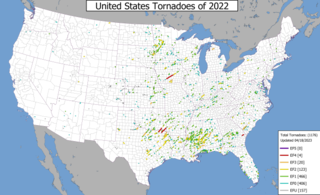
This page documents notable tornadoes and tornado outbreaks worldwide in 2022. Strong and destructive tornadoes form most frequently in the United States, Argentina, Brazil, Bangladesh, and Eastern India, but can occur almost anywhere under the right conditions. Tornadoes also develop occasionally in southern Canada during the Northern Hemisphere's summer and somewhat regularly at other times of the year across Europe, Asia, Argentina, Australia and New Zealand. Tornadic events are often accompanied by other forms of severe weather, including strong thunderstorms, strong winds, and hail.















